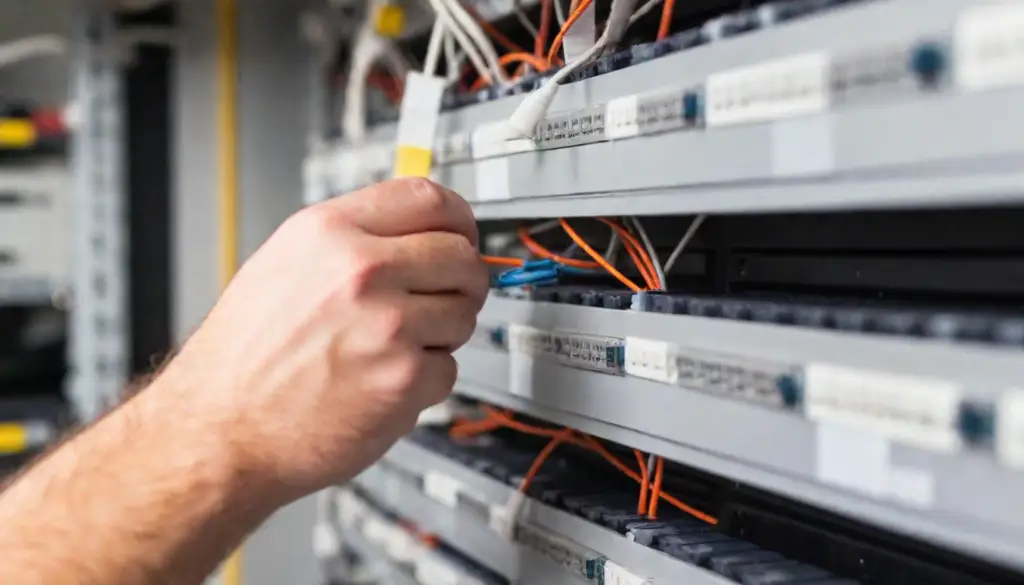The bundles of wires, conduits, and cabling that run over ceilings, behind walls, and into your server room are the arteries that keep a business running. Low-voltage and high-voltage cabling are two essential components of modern electrical systems. They play a critical role in transmitting electrical signals and delivering electrical power to homes, businesses, and industries. Understanding the differences between these types of cabling is essential for anyone working in the electrical industry, as well as for those who need to install or maintain electrical systems.
What is Low-Voltage Cabling?
Low voltage cabling refers to the installation of cables and wiring that carry low voltage electrical signals, usually below 50 volts. It is used for a variety of applications including data communication, audio/visual systems, security systems, and lighting control systems.
Low voltage cabling is an important aspect of modern building and infrastructure design, as it allows for the integration of various communication and control systems into a single, cohesive network. Proper installation and maintenance of low voltage cabling is essential for ensuring the reliable and efficient operation of these systems.
What is High-Voltage Cabling?
High voltage cabling refers to the installation of cables and wiring that carry high voltage electrical signals, typically above 1000 volts. It is used for the transmission and distribution of electrical power in large-scale electrical systems, such as utility grids and industrial power systems.
High voltage cabling plays a critical role in modern society, as it enables the efficient and reliable delivery of electrical power to homes, businesses, and industries. Proper installation and maintenance of high voltage cabling is essential for ensuring the safety and reliability of electrical power systems.
What is the Difference Between High- and Low-Voltage Cabling?
High-voltage wiring exists in all industries. A high-voltage cable is a cable used for electric power transmission at high voltage. This type of cabling carries electricity to power outlets, fixtures, and switches, but the high voltage also carries the risk of electrocution. As such, high voltage wiring has stringent codes and regulations and should always be installed by a licensed or master electrician.
Conversely, low-voltage cabling (also called structured wiring) is electrical wiring and trim that requires less current to power infrastructural technologies such as phones, security wires, fire alarms, intercoms, internet, etc. Low-voltage wires are far less scrutinized during inspections because the open wire does not pose the same electrocution threat that standard (high-voltage) wires do.
What is Low-Voltage Wiring Used For?
Security & Surveillance
Low-voltage wiring is used for security and surveillance systems, such as burglar alarms, video cameras, and access control systems. These systems use low-voltage signals to transmit data and control the security components. Low-voltage wiring provides a safer and more reliable option for transmitting these signals, as compared to high-voltage wiring.
Telephone Systems
Wiring can be used for both traditional landline and VOIP (Voice over Internet Protocol) systems. This wiring carries low-voltage signals for both voice and data transmission, and is essential for providing reliable and efficient telephone service.
Audio & Video System
Low-voltage wiring is used for audio and video systems, such as home theaters, surround sound systems, and commercial audio systems. This wiring carries low-voltage signals for audio and video transmission, providing clear and high-quality sound and picture.
WiFi & Internet Systems
Low-voltage wiring is used for WiFi and internet systems, including both home and commercial networks. This wiring carries signals for data transmission, providing reliable and fast internet and network access. It is an essential component of modern communication and technology systems.
The Importance of Low-Voltage Wiring
Low voltage wiring is essential for a business because they handle the bulk of its technology infrastructure. Since low voltage cabling doesn’t require a master electrician to install, impulsive companies often take a “Do-It-Yourself” (DIY) approach and try to install all structured wiring in-house. Unfortunately, this approach is short-sighted and often leads to long-term headaches. Since low voltage wiring handles so many vital systems, it’s easy to get trapped in a tangled web of computer networks, customer interface, HD video, audio, and Wi-Fi cabling.
Furthermore, low voltage data cabling wires have subtle spec differences that can throttle infrastructures. Imagine paying for one gigabyte per second internet, and only receiving a fraction of that capability due to insufficient wiring. While it might be too costly to hire a master electrician to run low voltage cables, you can easily partner with an experienced technology company that specializes in cabling logistics. Partners should provide certified technicians that lay tidy and fully customized cabling and account for past, present, and future technology infrastructure challenges.
Enlist the Help of Cabling Experts
We’ve all heard the proverb, “a chain is only as strong as its weakest link.” This logic is particularly appropriate for businesses: “Technology infrastructure is only as strong as its faultiest wire.” As companies grow, technology systems often get more and more complex. In some cases, the cabling infrastructure configuration will have to accommodate varying capacities across multiple facilities in various states. The need for different offices to seamlessly collaborate in separate locations or even geographies can create logistical challenges. It only takes one location to mismanage its systems for an entire company to encounter downtime.
Partnering with a trusted technology project management company alleviates these issues. Here at Teksetra, we deploy on-demand technicians everywhere in the U.S. These expert technology mechanics are equipped with the best equipment, processes, and training to ensure your company’s cabling is set up for maximal success.
Don’t Cut Corners
Low-voltage cabling installation determines the security, reliability, and speed of a company’s operations. Therefore, organizations looking to build in, improve, or upgrade their structured wiring situations should seek expert help. As CEDIA, the global trade association for companies that design, manufacture, and integrate technology states, “The most expensive cable that can be installed is the one that did not get installed [correctly] in the first place.” Structured wiring is like cable management’s hydra: take away one cable and two more come back. As companies expand, more and more data cables are required, and simple cable installations become complex. While it may seem appealing to take a DIY approach, hopefully, this article demonstrates the importance of investing in a partner specializing in proper low-voltage cable management, installation, and ongoing support.
Looking for support?





